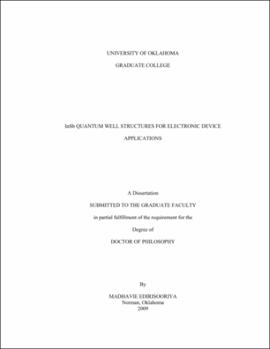| dc.contributor.advisor | Santos, Michael B | |
| dc.creator | Edirisooriya, Madhavie | |
| dc.date.accessioned | 2019-04-27T21:37:16Z | |
| dc.date.available | 2019-04-27T21:37:16Z | |
| dc.date.issued | 2009 | |
| dc.identifier | 99351648002042 | |
| dc.identifier.uri | https://hdl.handle.net/11244/319173 | |
| dc.description.abstract | The electron effective mass is smaller in InSb than in any other III-V semiconductor. Since the electron mobility depends inversely on the effective mass, InSb-based devices are attractive for field effect transistors, magnetic field sensors, ballistic transport devices, and other applications where the performance depends on a high mobility or a long mean free path. In addition, electrons in InSb have a large g-factor and strong spin orbit coupling, which makes them well suited for certain spin transport devices. | |
| dc.description.abstract | The first n-channel InSb high electron mobility transistor (HEMT) was produced in 2005 with a power-delay product superior to HEMTs with a channel made from any other III-V semiconductor. The high electron mobility in the InSb quantum-well channel increases the switching speed and lowers the required supply voltage. This dissertation focuses on several materials challenges that can further increase the appeal of InSb quantum wells for transistors and other electronic device applications. | |
| dc.description.abstract | First, the electron mobility in InSb quantum wells, which is the highest for any semiconductor quantum well, can be further increased by reducing scattering by crystal defects. InSb-based heteroepitaxy is usually performed on semi-insulating GaAs (001) substrates due to the lack of a lattice matched semi-insulating substrate. The 14.6% mismatch between the lattice parameters of GaAs and InSb results in the formation of structural defects such as threading dislocations and microtwins which degrade the electrical and optical properties of InSb-based devices. Chapter 1 reviews the methods and procedures for growing InSb-based heterostructures by molecular beam epitaxy. | |
| dc.description.abstract | Chapters 2 and 3 introduce techniques for minimizing the crystalline defects in InSb-based structures grown on GaAs substrates. Chapter 2 discusses a method of reducing threading dislocations by incorporating AlyIn1-ySb interlayers in an AlxIn1-xSb buffer layer and the reduction of microtwin defects by growth on GaAs substrates that are oriented 2° away from the [011] direction. Chapter 3 discusses designing InSb QW layer structures that are strain balanced. By applying these defect-reducing techniques, the electron mobility in InSb quantum wells at room temperature was significantly increased. | |
| dc.description.abstract | For complementary logic technology, p-channel transistors with high mobility are equally as important as n-channel transistors. However, achieving a high hole mobility in III-V semiconductors is challenging. A controlled introduction of strain in the quantum-well material is an effective technique for enhancing the hole mobility beyond its value in bulk material. The strain reduces the hole effective mass by splitting the heavy hole and light hole valence bands. Chapter 4 discusses a successful attempt to realize p-type InSb quantum well structures. The biaxial strain applied via a relaxed metamorphic buffer resulted in a significantly higher room-temperature hole mobility and a record high low-temperature hole mobility. | |
| dc.description.abstract | To demonstrate the usefulness of high mobility in a device structure, magnetoresistive devices were fabricated from remotely doped InSb QWs. Such devices have numerous practical applications such as position and speed sensors and as read heads in magnetic storage systems. In a magnetoresistive device composed of a series of shorted Hall bars, the magnetoresistance is proportional to the electron mobility squared for small magnetic fields. Hence, the high electron mobility in InSb QWs makes them highly preferable for geometrical magnetoresistors. Chapter 5 reports the fabrication and characterization of InSb quantum-well magnetoresistors. The excellent transport properties of the InSb QWs resulted in high room-temperature sensitivity to applied magnetic fields. | |
| dc.description.abstract | Finally, Chapter 6 provides the conclusions obtained during this research effort, and makes suggestions for future work. | |
| dc.format.extent | 159 pages | |
| dc.format.medium | application.pdf | |
| dc.language | en_US | |
| dc.relation.requires | Adobe Acrobat Reader | |
| dc.subject | Indium antimonide crystals | |
| dc.subject | Quantum wells | |
| dc.subject | Modulation-doped field-effect transistors | |
| dc.subject | Semiconductors | |
| dc.title | InSb QUANTUM WELL STRUCTURES FOR ELECTRONIC DEVICE APPLICATIONS | |
| dc.type | text | |
| dc.type | document | |
| dc.thesis.degree | Ph.D. | |
| ou.group | College of Arts and Sciences::Homer L. Dodge Department of Physics and Astronomy | |
